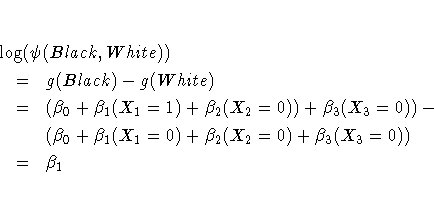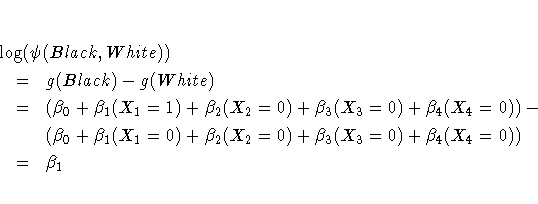Chapter Contents
Previous
Next
|
Chapter Contents |
Previous |
Next |
| The LOGISTIC Procedure |

The odds ratio ![]() is
defined as the ratio of the odds for those with the risk factor (X=1)
to the odds for those without the risk factor (X=0). The log of the
odds ratio is given by
is
defined as the ratio of the odds for those with the risk factor (X=1)
to the odds for those without the risk factor (X=0). The log of the
odds ratio is given by

The parameter, ![]() , associated with X
represents the change in the log odds
from X = 0 to X = 1.
So, the odds ratio is obtained by simply exponentiating the
value of the parameter associated with the risk factor. The
odds ratio indicates how
the odds of event change as you change X from 0 to 1. For
instance,
, associated with X
represents the change in the log odds
from X = 0 to X = 1.
So, the odds ratio is obtained by simply exponentiating the
value of the parameter associated with the risk factor. The
odds ratio indicates how
the odds of event change as you change X from 0 to 1. For
instance, ![]() means that the odds of an event when
X=1 are twice the odds of an event when X=0.
means that the odds of an event when
X=1 are twice the odds of an event when X=0.
Suppose the values of the dichotomous risk factor are coded
as constants a and b instead of 0 and 1. The odds when
X = a become ![]() , and the odds when
X = b become
, and the odds when
X = b become ![]() . The odds ratio
corresponding to an increase in X from a to b is
. The odds ratio
corresponding to an increase in X from a to b is
![\psi = \exp[(b - a) \beta_1] = [\exp(\beta_1)]^{b-a} \equiv
[\exp(\beta_1)]^c](images/lgseq149.gif)
For a polytomous risk factor, the computation of odds ratios depends on how the risk factor is parameterized. For illustration, suppose that Race is a risk factor with four categories: White, Black, Hispanic, and Other.
For the effect parameterization scheme (PARAM=EFFECT) with White as the reference group, the design variables for Race are as follows.
| Design Variables | |||
| Race | X1 | X2 | X3 |
| Black | 1 | 0 | 0 |
| Hispanic | 0 | 1 | 0 |
| Other | 0 | 0 | 1 |
| White | -1 | -1 | -1 |
The log odds for Black is

The log odds for White is

Therefore, the log odds ratio of Black versus White becomes

For the reference cell parameterization scheme (PARAM=REF) with White as the reference cell, the design variables for race are as follows.
| Design Variables | |||
| Race | X1 | X2 | X3 |
| Black | 1 | 0 | 0 |
| Hispanic | 0 | 1 | 0 |
| Other | 0 | 0 | 1 |
| White | 0 | 0 | 0 |
The log odds ratio of Black versus White is given by

For the GLM parameterization scheme (PARAM=GLM), the design variables are as follows.
| Design Variables | ||||
| Race | X1 | X2 | X3 | X4 |
| Black | 1 | 0 | 0 | 0 |
| Hispanic | 0 | 1 | 0 | 0 |
| Other | 0 | 0 | 1 | 0 |
| White | 0 | 0 | 0 | 1 |
The log odds ratio of Black versus White is

Consider the hypothetical example of heart disease among race in Hosmer and Lemeshow (1989, p 44). The entries in the following contingency table represent counts.
| Race | ||||
| Disease Status | White | Black | Hispanic | Other |
| Present | 5 | 20 | 15 | 10 |
| Absent | 20 | 10 | 10 | 10 |
The computation of odds ratio of Black versus White for various parameterization schemes is tabulated in the following table.
| Odds Ratio of Heart Disease Comparing Black to White | |||||
| Parameter Estimates | |||||
| PARAM | Odds Ratio Estimation | ||||
| EFFECT | 0.7651 | 0.4774 | 0.0719 | exp(2 ×0.7651 + 0.4774 + 0.0719) = 8 | |
| REF | 2.0794 | 1.7917 | 1.3863 | exp(2.0794) = 8 | |
| GLM | 2.0794 | 1.7917 | 1.3863 | 0.0000 | exp(2.0794) = 8 |
Since the log odds ratio (![]() ) is a linear function of the parameters, the Wald confidence interval
for
) is a linear function of the parameters, the Wald confidence interval
for ![]() can be derived from the parameter estimates and the estimated covariance
matrix.
Confidence intervals for the odds ratios are obtained by exponentiating
the corresponding confidence intervals for the log odd ratios.
In the displayed output of PROC LOGISTIC,
the "Odds Ratio Estimates" table
contains the odds ratio estimates and the corresponding 95% Wald confidence
intervals.
For continuous explanatory variables,
these odds ratios correspond to a unit increase in the
risk factors.
can be derived from the parameter estimates and the estimated covariance
matrix.
Confidence intervals for the odds ratios are obtained by exponentiating
the corresponding confidence intervals for the log odd ratios.
In the displayed output of PROC LOGISTIC,
the "Odds Ratio Estimates" table
contains the odds ratio estimates and the corresponding 95% Wald confidence
intervals.
For continuous explanatory variables,
these odds ratios correspond to a unit increase in the
risk factors.
To customize odds ratios for specific units of change for a continuous risk factor,
you can use the
UNITS statement to specify a
list of relevant units for each explanatory variable in the model.
Estimates of these customized odds ratios are given in a separate table.
Let (Lj,Uj)
be a confidence
interval for ![]() . The corresponding lower and
upper confidence limits for the customized odds ratio
. The corresponding lower and
upper confidence limits for the customized odds ratio ![]() are exp[cLj]
and exp[cUj], respectively (for c>0),
or exp[cUj] and exp[cLj], respectively (for c<0).
You use the CLODDS= option to request the confidence intervals
for the odds ratios.
are exp[cLj]
and exp[cUj], respectively (for c>0),
or exp[cUj] and exp[cLj], respectively (for c<0).
You use the CLODDS= option to request the confidence intervals
for the odds ratios.
|
Chapter Contents |
Previous |
Next |
Top |
Copyright © 1999 by SAS Institute Inc., Cary, NC, USA. All rights reserved.